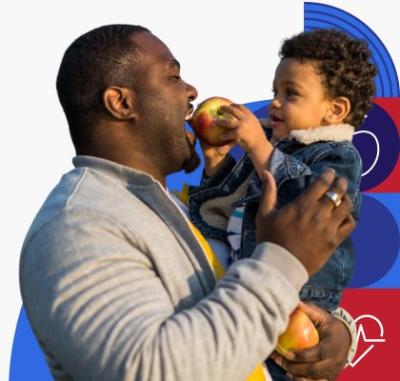Health Conditions
Help Your Child Stay at a Healthy Weight

The Basics
Overview
Help your child — and your whole family — eat healthy and stay physically active. The healthy habits your child learns now can last a lifetime.
What can I do to help my child stay at a healthy weight?
Two of the best ways to help your child stay at a healthy weight are to:
- Help your child and family eat healthier foods — like fruits, vegetables, and whole grains
- Be more physically active as a family — like by walking, swimming, or playing at the park
It’s also important that your child builds other healthy habits — like getting enough sleep and limiting screen time — to support their overall health and help them stay at a healthy weight.
Be a role model.
Parents and caregivers are often the most important role models for children. When you choose to eat healthy and be physically active, your child will be more likely to make those choices, too.
Plus, being active and preparing healthy meals together are great ways to spend quality time with your family.
Learn more about how you can help your children build healthy routines.
Look at these websites with your child.
These kid-friendly websites can help you and your child learn about healthy habits.
Health Effects
Why is it important for my child to stay at a healthy weight?
Growing up at a weight that’s right for your child can help them stay healthy through adulthood. People at higher weights may have conditions called overweight or obesity. This means that the body has too much body fat. Having overweight or obesity in childhood or adolescence can raise your child’s risk for serious health problems, like:
- Breathing problems
- Type 2 diabetes
- Sleep problems
- Heart problems
- Kidney and liver problems
Having overweight or obesity as a child is also linked to:
- Anxiety and depression
- Low self-esteem
- Being bullied, teased, or viewed negatively by others because of weight
Learn more about health problems and childhood obesity.
Keep in mind that higher weight during childhood raises the risk of higher weight as an adolescent and young adult. In other words, many kids don’t “grow out of” having excess weight.
Today, about 7 in 10 adults — and about 4 in 10 children and teens — have overweight or obesity.
Find Out if Your Child is at a Healthy Weight
How do I know if my child is at a healthy weight?
Because children grow at different rates as they age, it’s not always easy to tell if they’re at a healthy weight. The best way to find out if your child is at a healthy weight is to work with their doctor.
For children ages 2 years and older, body mass index (BMI) is one way doctors can learn if your child is at a healthy weight for their age, sex, and height. Measuring BMI can help the doctor know if your child is underweight, at a healthy weight, or if they have overweight or obesity. Your child’s doctor will also consider other factors, like your child’s family history and physical exam.
You can also use this BMI calculator for children and teens if you know your child’s height and weight.
What if my child has overweight or obesity?
There are many factors that can lead to a child having overweight or obesity — including their eating and physical activity habits, stress, anxiety, other health problems, and genes. A child’s environment — where they live, learn, and play — also has a big impact.
If your child’s doctor is concerned about their weight, there are steps you can take as a family to help them get to a healthier weight. Your family can:
- Move more — find physical activities that you enjoy
- Choose healthier foods and plan ahead for meals — try to eat a variety of healthy foods, including fruits, vegetables, whole grains, low-fat dairy, and lean protein foods
- Set a good example for your child — try to make healthy choices for yourself too, like eating vegetables instead of chips or drinking water instead of sugary drinks
- Limit less healthy foods and drinks — like foods and drinks that have a lot of added sugars, saturated fat, and sodium
- Get enough sleep — try limiting screen time before bed and going to sleep and waking up at the same time each day
Making healthy life changes can be hard. To get support, look for programs (called family healthy weight programs) that help families build healthy habits. Ask your child’s doctor if they can recommend a program, or look for resources in your community through programs like WIC (Special Supplemental Nutrition Program for Women, Infants, and Children), SNAP (Supplemental Nutrition Assistance Program), or recreation centers.
You can also check out these resources to learn how to cut down on foods with:
Some children might need other treatments to help manage their weight. For example, medicines or surgery might be an option for older children or teens. Ask your child’s doctor what they recommend for your child.
Take Action
See a Doctor
Ask your child’s doctor if your child’s weight is healthy.
Ask your child’s doctor or nurse about your child’s growth and health. BMI is one way doctors can learn if your child is at a healthy weight for their age, sex, and height, but they’ll also consider factors like family history and do a physical exam.
You can use this BMI calculator for children and teens if you know your child’s height and weight.
If the doctor finds that your child is underweight, they can talk with you about making changes to help your child is get to a healthy weight.
If your child has overweight or obesity, ask about treatment options.
If your child has overweight or obesity, ask the doctor or nurse for advice. One of the best ways to manage your child’s weight is to make healthy changes as a family. Treatment can also include medicines and working with a dietitian (a person who is an expert in healthy eating) or other doctors that treat weight problems.
Learn more about treatment options for overweight and obesity.
What about cost?
Under the Affordable Care Act, insurance plans must cover screening for obesity and counseling for family healthy weight programs for kids. Depending on your insurance plan, you may be able to get these services at no cost to you. Check with your insurance company to find out more.
Medicaid or the Children's Health Insurance Program (CHIP) may also cover obesity screening and counseling for your child at no cost. Learn about coverage options for your family.
If you don't have insurance, you may still be able to get free or low-cost obesity screening and treatment for your child. Find a health center near you and ask about obesity-related services for kids.
To learn more, check out these resources:
Get Enough Physical Activity
Make sure your child gets at least 60 minutes of physical activity every day.
Fun and simple activities, like playing tag, are great ways for kids to get moving. And it doesn’t have to be 60 minutes all at once — it can be shorter activities that add up to 60 minutes (1 hour) a day.
Be sure your child is doing different types of activity, including:
- Aerobic activities, like running, skipping, or dancing
- Muscle-strengthening activities, like climbing playground equipment or trees
- Bone-strengthening activities, like jumping rope or playing basketball
Find out more about physical activity for kids.
Get active as a family.
To help the whole family get more physical activity, you can:
- Let your child choose family activities
- Walk the dog or bike to the library together
- Dance while dinner's in the oven
- Post a family activity calendar on your refrigerator
- Find a park to explore near your home
- Build physical activity into running family errands — take the stairs instead of the elevator or park farther away from the entrance of the store
Check out these resources for more ideas:
Limit Screen Time
Spending time in front of screens, like TVs, tablets, or smartphones, often means that your child isn’t moving around or getting physically active. You can help your child build healthy habits for using screens. For example, you can:
- Set clear rules about when and for how long your child can do activities involving screen time
- Keep the TV out of your child’s room
- Use this screen time log [PDF - 144 KB] to track how much time your family is spending in front of screens
Serve Healthy Meals
Shop for, cook, and plan for healthy meals together.
Buy and serve more vegetables, fruits, whole-grain foods, fat-free or low-fat dairy, and a variety of protein foods. Be sure to offer a variety of healthy foods from different food groups at each meal.
Here are some tips and ideas for healthy eating as a family:
- Let your child pick out healthy foods to try — and remember it can take young kids up to 8 or 10 times of trying a new food to accept it
- Offer healthy beverages — like water or plain fat-free or low-fat milk (children under age 2 can drink whole milk) — instead of soda, flavored milks, or fruit drinks with added sugars
- Encourage your child to eat whole fruits and limit 100% fruit juice to small amounts (don’t give juice to kids younger than 12 months) — try keeping a bowl of fruit on the table for quick snacks
- Try preparing healthy foods in different ways — for example, try the same vegetable raw, roasted, or steamed with herbs and spices
- At snack time, give your child carrot sticks and hummus or apple slices with peanut butter instead of chips or cookies
- Start your child’s day off with a healthy breakfast — for example, offer whole-grain cereal or oatmeal with fat-free or low-fat milk and fruit instead of sugary cereal
- Encourage your child to stop eating when they’re full instead of when the plate is clean
Use these resources to:
- Learn how to help your child build a healthy eating routine [PDF - 1. 6 MB]
- Make a shopping list with healthy foods [PDF - 547 KB]
- Read the Nutrition Facts label on packages to help you make healthy choices
- Get more tips for smart food shopping
- Get more ideas for healthy snacks
- Learn how to make healthy drink choices [PDF - 1.2 MB]
Set a good example by eating healthy.
You can be a role model for your child by eating healthy yourself. Plus, a healthy diet can help protect you from heart disease, type 2 diabetes, and some types of cancer. Get more tips for eating healthy.
Need help paying for food?
There are programs that can help you pay for healthy food for your family. Ask your child’s doctor about:
- WIC (Women, Infants, and Children), a government program that supports women who are pregnant and breastfeeding and kids age 5 and younger. You can also use this tool to see if you qualify for WIC.
- SNAP (Supplemental Nutrition Assistance Program) — a government program that can help families with lower incomes buy food. Find out if you qualify for SNAP.
Sit at the table and eat together as a family.
Enjoy the healthy meals you plan and cook together as a family. When families eat together, children eat more vegetables and fruits and fewer foods with added sugars. Let your child help get ready for dinner time by setting the table.
Promote Healthy Sleep Habits
Make sure your child gets enough sleep.
Getting enough sleep, helps kids stay at a healthy weight. Make sure you know how much sleep your child needs :
- Teens need 8 to 10 hours of sleep each night
- School-aged children need 9 to 12 hours of sleep each night
- Preschoolers need to sleep between 10 and 13 hours each day (including naps)
- Toddlers need to sleep between 11 and 14 hours a day (including naps)
- Babies need between 12 and 16 hours of sleep each day (including naps)
Set a bedtime schedule and remind your child when it’s time to get ready for bed. Creating a calming bedtime routine that includes activities like reading a book or taking a warm bath can help. Consider keeping electronic devices — like TVs, tablets, and smart phones — out of the bedroom and stopping screen time at least 1 hour before bedtime. Get more tips on healthy sleep habits.
Content last updated January 31, 2025
Reviewer Information
This information on childhood obesity is adapted from materials from the National Heart, Lung and Blood Institute; the Office of the Surgeon General; and the Centers for Disease Control and Prevention.
Reviewed by:
Division of Nutrition, Physical Activity and Obesity
National Center for Chronic Disease Prevention and Health Promotion
Centers for Disease Control and Prevention


